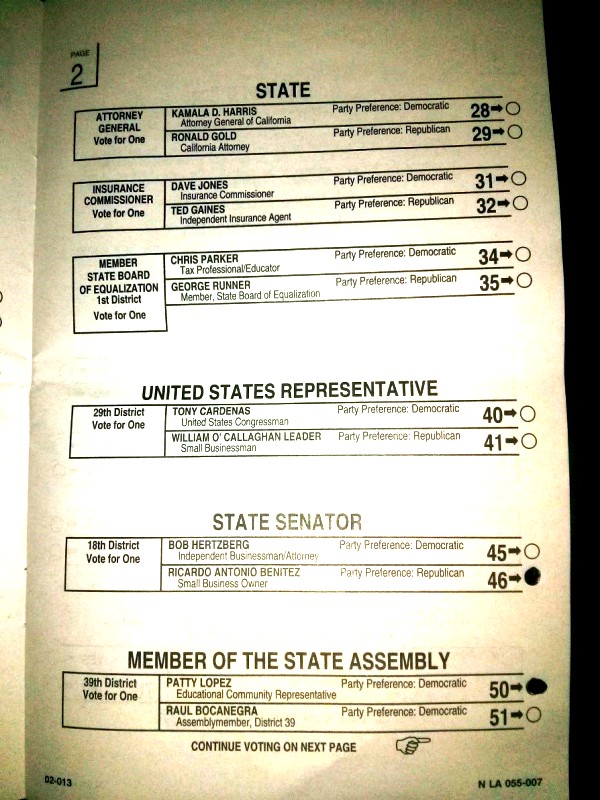Analysis
CA120: Conspiracy, numbers in the Lopez-Bocanegra battle
 Patty Lopez and Raul Bocanegra (Illustration by Tim Foster/Capitol Weekly)
Patty Lopez and Raul Bocanegra (Illustration by Tim Foster/Capitol Weekly)If someone comes to you and says, “I won my election because I was the first name on the ballot,” you should immediately check for the tinfoil hat — and then show them the door.
The notion that a democratic election for something as important as a legislative or congressional seat, or even a city council, can be decided by the order on a ballot is the domain of wild conspiracy theorists.
Until it actually happens.
An inordinate amount of political research has been done on this topic. The research shows that ballot order has a small impact, and that it matters just a bit more the further down the ballot a voter gets.
Ballot order may have played a role in the upset victory by Patty Lopez over incumbent Raul Bocanegra in Assembly District 39 in the San Fernando Valley.
Potentially, in municipal races or small obscure boards where the voter has little information with which to judge the candidates, it could sway the race by a couple percentage points at the most.
California knows about this issue: Our state laws protect against the phenomenon with the drawing of a random alphabet each election cycle to determine the order of placement on the ballot.
This random alphabet shifts one letter in each Assembly District so a statewide candidate with the lucky draw doesn’t benefit from the top position on the ballot throughout the entire state.
So, the consensus is that the impact of ballot ranking is tiny and not relevant to races of importance, and that the state’s random alphabet wipes away any potential benefit to a particular candidate.
Yet, in 2014 some observers said ballot order led to challenger Patty Lopez’s upset victory over incumbent Raul Bocanegra in Assembly District 39 in the San Fernando Valley.
The particulars of that election didn’t seem interesting or unique at the time.
It was a top-two runoff between two Latino candidates. Bocanegra, with significant financial resources and a strong reputation in Sacramento, faced Lopez, an opponent with no reported fundraising, endorsements, or apparent political organization.
In some states, one can vote a straight partisan ballot by just pulling a single lever. But in California, voters have to do it race-by-race.
This is the kind of race where incumbents regularly save their resources and expect a smooth re-election. And Bocanegra wasn’t an exception in this regard. He wasn’t even in his own district on Election Day, opting instead to be a part of activities by several legislators to help in swing seats.
Bocanegra had easily won the Primary, his polling showed a double-digit lead, and yet, he lost. This was likely the greatest legislative election upset in a generation.
But what about that ballot? Could the ballot order really have impacted the contest between Lopez and Bocanegra?
The argument goes that voters in this district have, for their entire lives, voted in General Elections that pitted a Republican against a Democrat in a traditional system. And the new “top two” primary changed that, creating confusion when the last race on the ballot was a Democrat versus a Democrat contest, and voters didn’t realize it.
Making matters worse, voters in this district got a ballot with each race, from governor to state Senate, listing the Democrat first, and Republican second. (This wasn’t intentional, it just so happened that the random alphabet put the Democrat first and Republican second in every race, an unlikely event with a probability of 1 in 1,024.)
This Democrat/Republican pattern went for two pages until the last contest where it was a Democrat Lopez first, then Democrat Bocanegra second. It is possible that voters attempting to vote a straight partisan ballot just voted for the first candidate they saw who was a Democrat.
In some states, one can vote a straight partisan ballot by just pulling a single lever.
But in California, voters have to do it race-by-race and, in their haste, voters in AD39 may have unknowingly voted for the first Democrat. This becomes a reasonable argument, but did it happen enough to give the victory to Lopez?
The Bocanegra campaign was so befuddled by this result they actually did a post-election poll which found — just like their pre-election polling — that they had a double-digit lead among likely voters and even among voters who had just cast ballots in the election!
But that poll obviously listed both candidates before asking who the respondent would support. And the polling might not have been able to mimic actual behavior in the polling booth when voters are trying to rush through a ballot.
It is unlikely that we will ever know how many people were actually confused when they were voting in this Democrat-vs.-Democrat race, but we can look around the state for other examples and find trends that substantiate the claim.
Four races in particular provide a really interesting laboratory for this analysis. These four contests, Congressional, Senate and Assembly, were races where:
- There were only two candidates, both from the same party;
- These candidates faced off in both the Primary and General Elections;
- The makeup of the electorate (partisanship, ethnicity) was not substantially different between the Primary and General Elections, both of which were historically low turnout;
- No significant spending was done by any of the challengers, and;
- The ballot order changed between the Primary and General because of the randomized alphabet.
| CA 19 | Candidate on Top | Result |
| Primary | Robert Murray | Lofgren by 34 pts |
| General | Zoe Lofgren | Lofgren by 52 pts |
| +18 points | ||
| SD 30 | ||
| Primary | Holly Mitchell | Mitchell by 71 pts |
| General | Isidro Armenta | Mitchell by 38 pts |
| -32 points | ||
| SD 40 | ||
| Primary | Ben Hueso | Hueso by 44 pts |
| General | Rafael Estrada | Hueso by 10 pts |
| -34 points | ||
| AD 47 | ||
| Primary | Cheryl Brown | Brown by 37 |
| General | Gil Navarro | Brown by 14 |
| -23 points |
The first noteworthy issue is that none of these changes from the top spot to the bottom changed the outcome.
But, they did have a very significant change in the vote totals.
On average, the candidate who went from the top spot in the Primary, to the bottom spot in the General, lost 27 points.
That’s a whopping change, all in the same direction, in contests where there was little or no evidence of anything external that would have caused the change in voter choices. (One could argue that a controversy in the Hueso re-election contributed to the changing result there, but even without that contest the average would be a 24-point shift.)
Post-election stories of the Mathis win called it “shocking” and “crazy,” and some attributed it to voters not supporting the Latino candidate.
There are a few other intra-party General Election races that aren’t as easy to analyze, but could also have the markers of this impact.
In the Assembly District 74 race, Republican Matt Harper came in second in the Primary to Republican Keith Curry, who had a higher ballot position. Then, in the General Election, Harper got the top ballot position and won by 19 points in a race where polling suggested a Curry win.
Similarly, polling was showing a win for Republican Rudy Mendoza in Assembly District 26, yet, on Election Day, Devin Mathis won by 8 points despite a 10-1 funding disadvantage.
Post-election stories of the Mathis win called it “shocking” and “crazy,” and some attributed it to voters not supporting the Latino candidate. But as we saw in last week’s article, this should have helped Mendoza with crossover Latino Democrats.
Could the ballot order in these intra-party contests actually be a drag on candidates, and create future surprises when ballot order puts an incumbent or a more well-funded front-runner in the second spot?
Analyses of the 2012 elections can address this issue a bit.
In that election cycle, there were also four elections with the same makeup as the ones analyzed above. But in all these races, the incumbents had either just moved into the district after redistricting, or were facing a serious challenger or even, in several cases, another incumbent.
There were still contests with 12-to-13-point shifts, but the overall impact was much less, likely because incumbents did not sit idle, expecting a smooth re-election. Conceivably, voters who were inundated with months of campaign activity from congressional members Laura Richardson and Janice Hahn were not going to be fooled by ballot order.
But getting back to the Bocanegra-Lopez battle: In the final analysis, we can’t say definitively that Assemblyman Bocanegra lost his election because of ballot order alone.
But we can say with some confidence that ballot order in intra-party General Elections does have a massive, double-digit, potential impact on the outcomes. The Bocanegra-Lopez election was decided by a margin much smaller than the average impact we see in these examples. This impact could have been wiped out by an aggressive campaign.
But who in their right mind would have spent significant campaign resources in an election that seemed, at the time, to be a shoo-in?
The lesson from the Bocanegra campaign may be that campaigns need to spend money on their re-elections just to insure against an embarrassing loss.
But, the data shows the candidates who really need to sweat it are those who draw an opponent from their own party and land in that deadly second spot.
—
Ed’s Note: Paul Mitchell, a regular contributor to Capitol Weekly, is vice president of Political Data Inc., and owner of Redistricting Partners, a political strategy and research company. Both firms provide information and strategy to Democratic, as well as Republican and independent candidates.
Want to see more stories like this? Sign up for The Roundup, the free daily newsletter about California politics from the editors of Capitol Weekly. Stay up to date on the news you need to know.
Sign up below, then look for a confirmation email in your inbox.

Leave a Reply